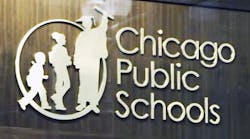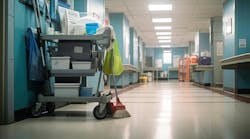Education administrators wouldn’t think of building a new school without first developing a plan to ensure that it is designed and constructed correctly. So once those schools are operating, it makes no sense to forgo planning when determining how to clean and maintain the facilities.
"A sound facilities maintenance plan serves as evidence that school facilities are, and will be, cared for appropriately," says the U.S. Department of Education’s Planning Guide for Maintaining School Facilities. "On the other hand, negligent facilities maintenance planning can cause real problems. Large capital investment can be squandered when buildings and equipment deteriorate or warranties become invalidated. Failing to maintain school facilities adequately also discourages future public investment in the education system."
Budget restraints and cuts in areas not directly tied to classroom learning have made it difficult for some schools and universities to fulfill the goals of a comprehensive maintenance plan, but the more education institutions can stick to the plan, the more likely they will be able to avoid deferring work and letting facilities deteriorate.
Comprehensive plan
The Florida Department of Education’s Maintenance and Operations Administrative Guidelines for School Districts and Community Colleges provides a lengthy list of tasks that should be covered in a maintenance management plan:
•Document through surveys, inventories and building manuals all facilities and equipment requiring maintenance services, and essential information for maintaining them.
•Determine the current serviceable or working condition of facilities, fixtures and equipment.
•Define the level of planned maintenance and maintenance priorities.
•Identify the appropriate budget, labor pool, equipment and supplies necessary to maintain a facility.
•Compare required funding with available funding; have detailed budgeting procedures to determine fiscal limitations.
•Define priority tiers for various maintenance tasks.
•Designate funds for specific purposes.
•Coordinate the overall maintenance workload with available budget allocations.
•Develop a master maintenance schedule that defines when various types of scheduled maintenance should be performed.
•Establish a control center for coordinating all maintenance-related work tasks.
•Develop procedures that assess maintenance department’s success in achieving its objectives and providing adequate services.
•Provide methods for generating management reports.
"Because maintenance requirements for educational buildings are ever present and likely to increase over time, it is essential that maintenance programs include inspections, preventative measures, routine service activities, work-order activities, repairs, upgrades, enhancements, and renovations as primary functions," the manual recommends.
Inadequate information
Education institutions may have good intentions about establishing a comprehensive maintenance plan and abiding by its directives, but in practice, managers may find it difficult to meet the goals set out in a plan when more urgent, short-term issues demand their attention.
A research paper from 2008 by two professors at Texas A&M University found that many public schools in Texas did not have adequate maintenance plans. "Facilities Maintenance Management Practices in Large Public Schools, Texas" published by Sarel Lavy and David Bilbo in the journal, Facilities, concluded that "a poor quality of facilities maintenance management practices exists in large public schools in Texas."
The researchers surveyed facility or maintenance managers at 72 large schools in Houston, San Antonio, Dallas and Austin.
"Although the majority of the schools considered maintenance planning to be an important part of the overall organizational plan, most of them do not have adequate information about their facility’s condition, which is essential for planning," the authors say.
Among their findings:
•Only 64 percent of the schools had a well conceived maintenance plan that guides facility improvement.
•33.3 percent of those surveyed said they did not know whether their school had a written facilities maintenance plan; another 3 percent said their school did not have such a plan.
•Although teachers and students are the most important users of a school facility, 43 percent of the schools did not include teachers and 75 percent of them did not include students in their long-term maintenance planning. For short-term maintenance planning, the percentages are even lower; about 75 percent of schools did not include teachers, and about 96 percent excluded students.
"Teachers and stakeholders are very seldom, students are rarely, and parents are never included in the process of short-range maintenance planning," the researchers say. "Since teachers and students are the most important users of the school facility, their inclusion in planning is necessary as their comfort level for teaching and learning is very important."
•About 28 percent of those survey ed said their schools never update their long-term maintenance plan. "It is crucial to update long-range maintenance plans (2 to 7 years duration), as facility conditions change rapidly," the authors state.
•31 percent of the schools surveyed conduct a facility condition assessment only once every three to five years. "This is a very long period, as facility conditions change rapidly and the importance of current building condition information is vital for facilities maintenance planning," the researchers say.
•Less than 50 percent of the schools use the findings in facility condition assessments for long-term planning and for establishing benchmarks for building components’ service life. Only 51 percent of the schools used the information for preventive maintenance. Schools that conducted more thorough assessments as recommended by the U.S. Department of Education had more information in their databases, and were in a better position to plan for facility needs by using that information for short- and long-range planning, planning preventive maintenance, and establishing benchmarks.
Sidebar: How Many?
A key factor in carrying out a school maintenance plan is determining how many workers are needed to get the job done properly.
In a 2011 operations review of maintenance operations in the Unionville-Chadds Ford District, the Pennsylvania Association of School Business Officials (PASBO) spelled out a staffing formula it relies on to determine the number of full-time-equivalent custodians needed to clean school buildings. The factors weighed: number of teachers, number of students, type of school, size of facility and the number of washroom fixtures:
•Number of teachers divided by 9.
•Number of students divided by 300 for elementary schools and 200 for secondary schools.
•Number of teaching stations divided by 12.
•Amount of building square footage divided by 16,000.
•Number of washroom fixtures divided by 35.
The average of all five factors determines the number of cleaning custodians needed, PASBO says.
A maintenance manual for the Arkansas Division of Public School Academic Facilities and Transportation uses a calculation it calls the “Omaha Formula” to determine custodial and maintenance staffing for elementary and secondary schools. In addition to factors such as building size, numbers of students and teachers, and type of school, it says that schools with stadiums, gymnasiums and swimming pools will need more workers, as well as education facilities with carpeting.
Kennedy, staff writer, can be reached at [email protected].



